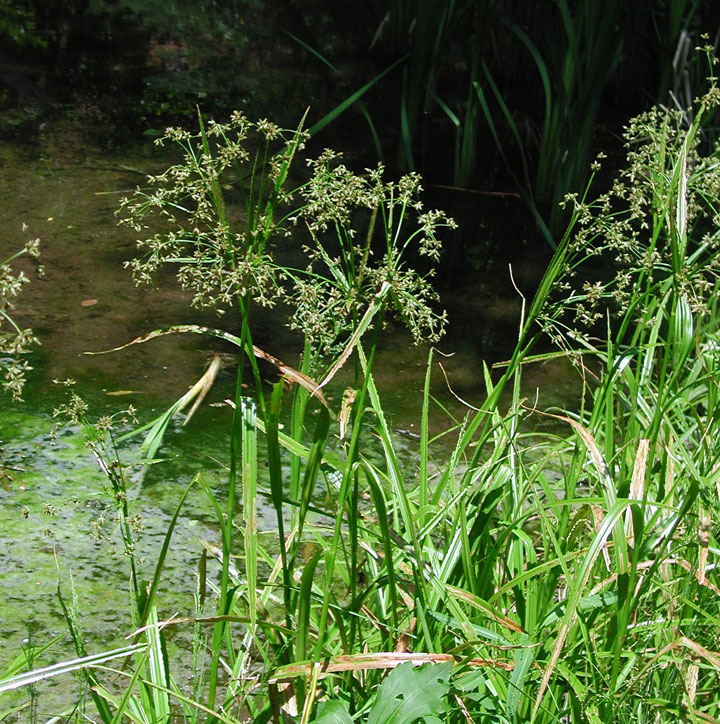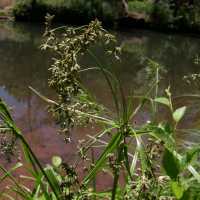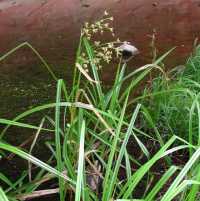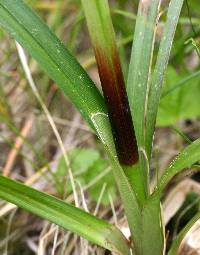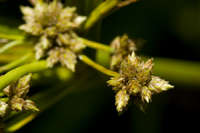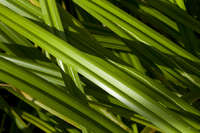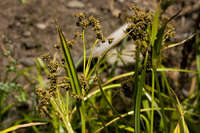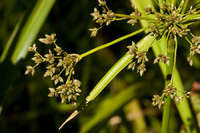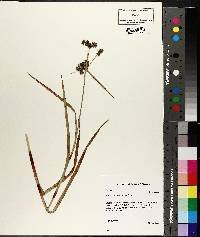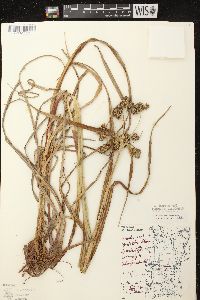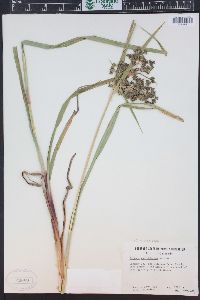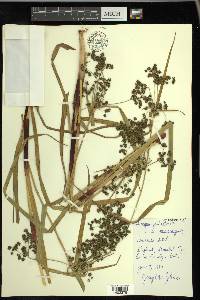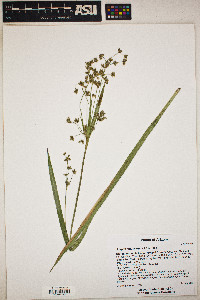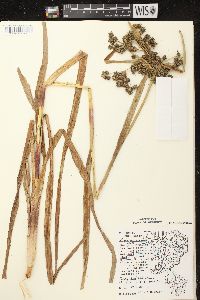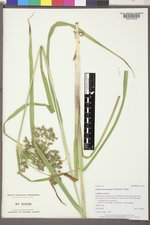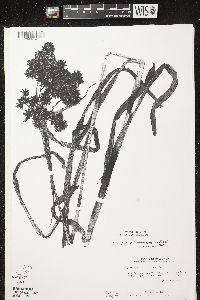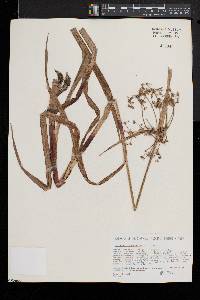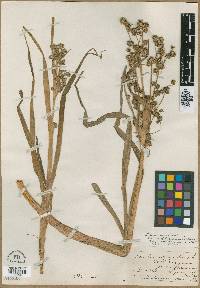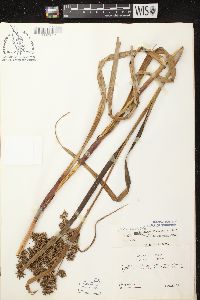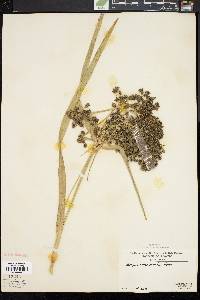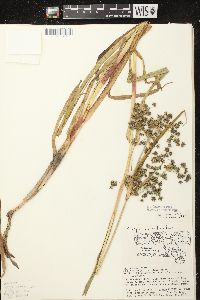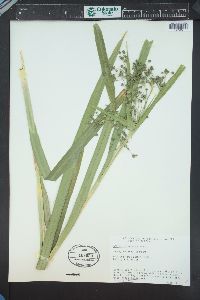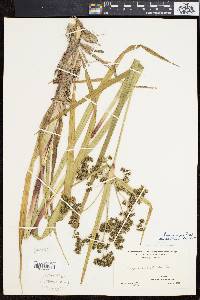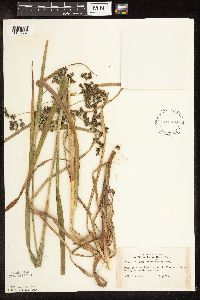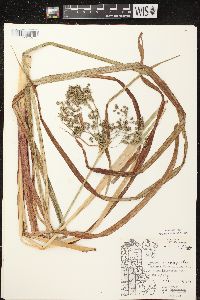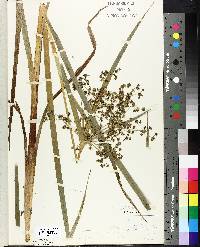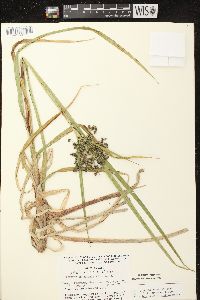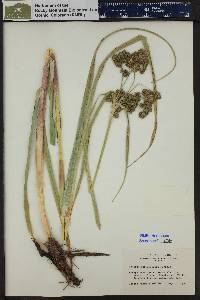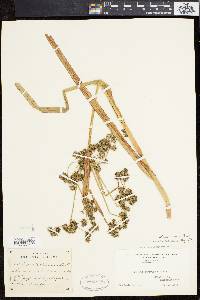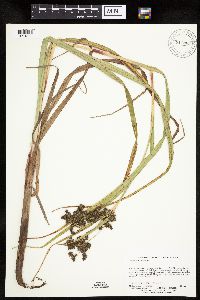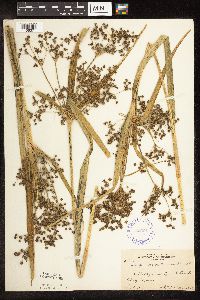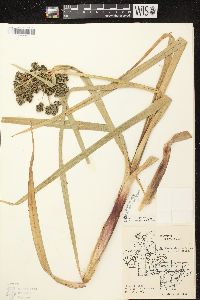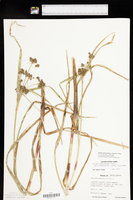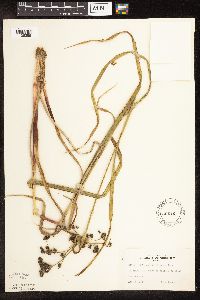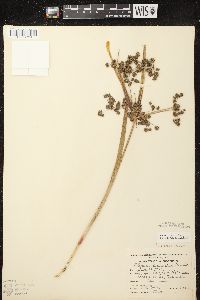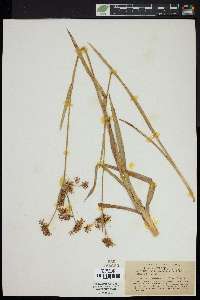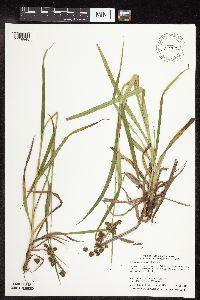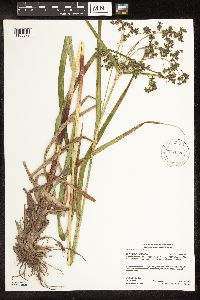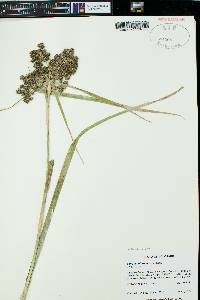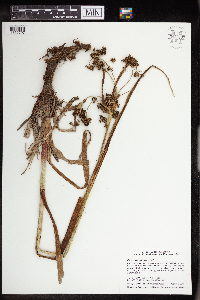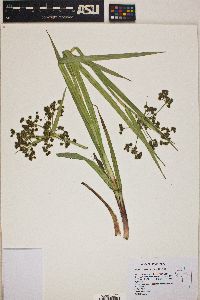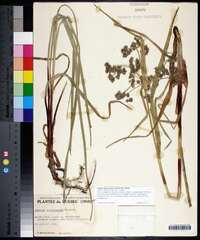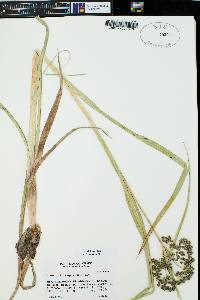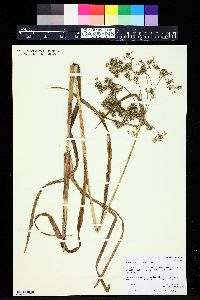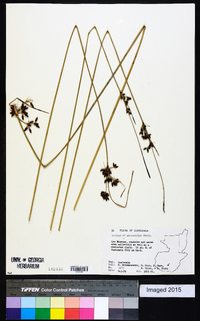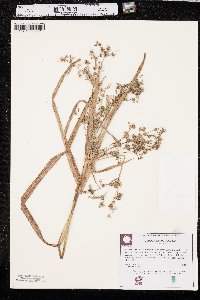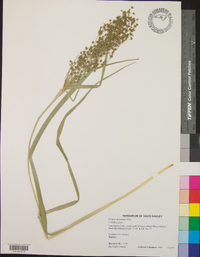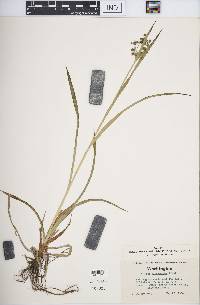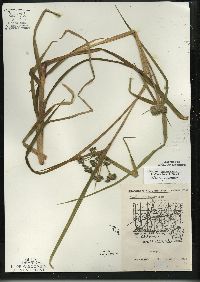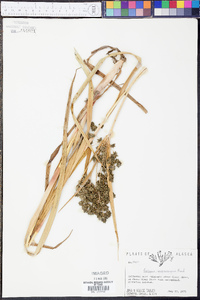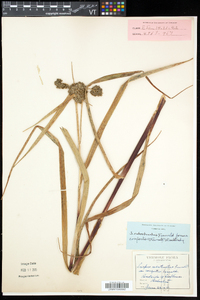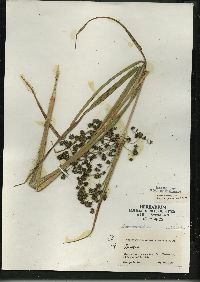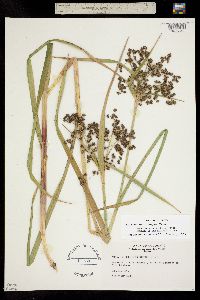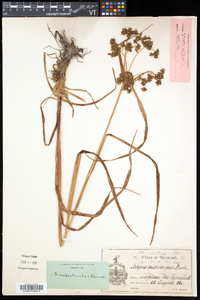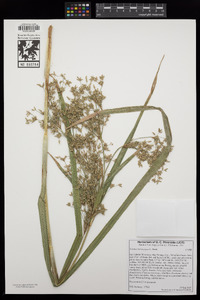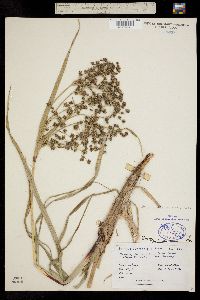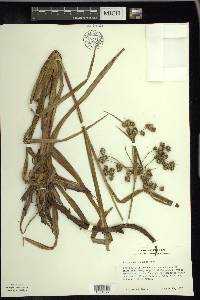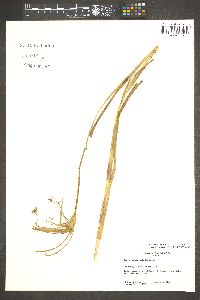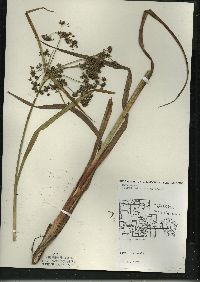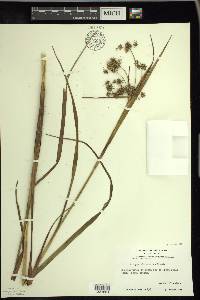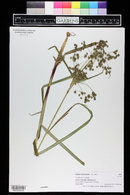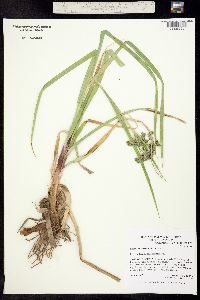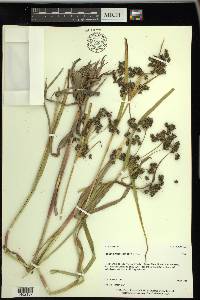
|
|
|
|
Family: Cyperaceae
panicled bulrush, more...Red-Tinge Bulrush, smallfruit bulrush
[Scirpus macounii, moreScirpus microcarpus var. longispicatus M.E. Peck, Scirpus microcarpus var. rubrotinctus (Fernald) M.E. Jones, Scirpus rubrotinctus Fernald, Scirpus rubrotinctus f. radiosus Fernald, Scirpus rubrotinctus var. confertus Fernald] |
Plants spreading; rhizomes reddish, long, with conspicuous nodes and internodes. Culms: fertile ones upright or nearly so; nodes without axillary bulblets. Leaves 4-11 per culm; sheaths of proximal leaves red; proximal sheaths and blades with septa few to many, conspicuous or inconspicuous; blades 23-60(-75) cm × 5-15(-20) mm. Inflorescences terminal; rays divaricate or ascending, proximal branches almost smooth, distal branches scabrous, rays without axillary bulblets; bases of involucral bracts green, black, or red, not glutinous. Spikelets in dense clusters of (1-)3-18 (largest cluster with 6 or more spikelets), spikelets sessile, 2-8 × 1-3.5 mm, ovoid or narrowly ovoid; scales green or black, broadly ovate or ovate to broadly elliptic or elliptic, 1.1-3.4 mm, apex rounded to acute or apiculate or occasionally mucronate, apiculus or mucro (if present) to 0.2 mm. Flowers: perianth bristles persistent, (3-)4(-6) per flower, stout, straight or curved, shorter than to 1.5 times as long as achene, with retrorse, thick-walled, sharp-pointed teeth densely arranged almost to base, enclosed within (occasionally weakly projecting from) scales; styles 2(-3)-fid. Achenes almost white, ovate to obovate in outline, biconvex to plano-convex, 0.7-1.6 × 0.8-1 mm. 2n = 64, 66. Fruiting early summer (Jun-Jul). Marshes, moist meadows, ditches; 0-2900 m; St. Pierre and Miquelon; Alta., B.C., Man., N.B., Nfld. and Labr., N.W.T., N.S., Ont., P.E.I., Que., Sask., Yukon; Alaska, Ariz., Calif., Colo., Conn., Idaho, Ill., Ky., Maine, Mass., Mich., Minn., Mont., Nebr., Nev., N.H., N.J., N.Mex., N.Y., N.Dak., Oreg., Pa., R.I., S.Dak., Utah, Vt., Wash., W.Va., Wis., Wyo.; Mexico (Baja California); e Asia (Kamchatka Peninsula). Scirpus microcarpus occasionally hybridizes with S. expansus, particularly in New England. Populations of Scirpus microcarpus from eastern United States have been treated as a distinct species, S. rubrotinctus Fernald. Populations from the central part of the continent are intermediate for the characters Fernald used to separate S. rubrotinctus. The taxonomy of the group should be reinvestigated. Populations from the Queen Charlotte Islands (British Columbia) have a different chromosome number (2n = 64; R. L. Taylor and G. A. Mulligan 1968) than populations from New York and Pennsylvania (2n = 66; A. E. Schuyler 1967, 1976).
Perennial herb with long, reddish rhizomes, spreading 0.6 - 1.5 m tall Leaves: three-ranked, four to eleven per culm. Sheaths of lower leaves reddish. Blades 20 cm - 0.6 m long, 5 - 15 mm wide, flat, grass-like, keeled beneath. Inflorescence: a large arrangement of spikelet clusters, terminal, many-branched with numerous ascending or diverging stalks, subtended by three leaf-like bracts. Bracts green, black, or reddish basally, unequal, the longest 10 - 30 cm long. Flowers: minute, subtended by a floral scale, lacking sepals and petals, bearing three to six (usually four) persistent bristles. Bristles stout, slender, curved or straight, shorter than to one and a half times as long as achene, bearing many small sharp teeth, enclosed inside the scales. Stamens one to three, exserted. Pistil one. Style linear, two-cleft (or some three-cleft), base persistent. Fruit: a one-seeded achene, nearly white, 0.5 - 1.5 mm long, about 1 mm wide, egg-shaped to reverse egg-shaped, biconvex or plano-convex (flat on one side and convex on the other), minutely bumpy. Culm: 0.6 - 1.5 m long, three-sided, solid. Spikelets: in dense clusters of three to eighteen, stalkless, 2 - 8 mm long, 1 - 3.5 mm wide, narrowly egg-shaped to egg-shaped. Floral scales spirally arranged, green or blackish, 1 - 3.5 mm long, egg-shaped or widely egg-shaped to elliptic to widely elliptic with a pointed or rounded apex that sometimes bears a tiny point. Similar species: No information at this time. Flowering: August to September Habitat and ecology: Rare in the Chicago Region, and known only from Lake County, Illinois, where it grows in marshy ground. Occurence in the Chicago region: native Etymology: Scirpus comes from the Latin name for a bulrush. Microcarpus comes from the words micro, meaning small, and carpos, meaning "fruit." Author: The Morton Arboretum Cronquist et al. 1977, Martin and Hutchins 1980, Kearney and Peebles 1969 Common Name: panicled bulrush Duration: Perennial Nativity: Native Lifeform: Graminoid General: Coarse perennial from stout, creeping rhizomes, stems arising singly or a few together 60-150 cm tall, obscurely three sided. Vegetative: Several flat grasslike blades, 8-15 mm wide, scabrous margins, sometimes exceeding the stems, sheaths tinted reddish-purple. Inflorescence: Spikelets in terminal compound loose umbels, spikelets 4-6 mm long, numerous, sessile in small pedunculate clusters, subtended by several conspicuous leaflike and unequal sheathless bracts, 10-30 cm long; scales numerous about 1.5 mm long, hyaline and reticular, blackish to greenish black in aspect, with green, ill-defined midstripe ending in a minute point; bristles 4-6, slender, minutely and retrorsely barbellate, slightly surpassing achene; achene lenticular, pale, 1-1.5 mm long, including minute apical awn. Ecology: Found on wet soils from 4,000-7,000 ft (1219-2134 m); flowers June-August. Notes: Distinguished from Schoenoplectus americanus by virtue of the compound umbel of spikelets, this is distinctive among the Scirpus/Schoenoplectus in the region. Ethnobotany: Unknown Etymology: Schoenoplectus coms from Greek schoinos for rush, reed or cord and plektos, for twisted or plaited, while microcarpus means having small fruits or seed pods. Synonyms: Scirpus microcarpus var. longispicatus, Scirpus microcarpus var. rubrotinctus, Scirpus rubrotinctus Editor: SBuckley, 2010 Coarse, leafy-stemmed perennial from stout creeping rhizomes; stems arising singly or few together, 6-15 dm, obscurely trigonous; lvs several, with flat, grass-like blade (6-)8-15 mm wide and up to several dm long, the sheaths ±anthocyanic; spikelets 4-6(-8) mm, very numerous, sessile in small, pedunculate clusters in a compound, umbelliform, terminal cyme that is subtended by several conspicuous, lf-like, unequal, sheathless bracts, the longest of these mostly 1-3 dm; scales numerous, 1-2 mm, largely hyaline and cellular-reticulate, blackish or greenish-black with greener, ill-defined midrib that may be very shortly excurrent; bristles 4-6, slender, minutely and retrorsely barbellate, slightly surpassing the achene; style bifid (or a few trifid); achenes pale, 1.0-1.2 mm, including the minute stylar apiculus, lenticular or a few trigonous; 2n=62, 66. Wet low ground; Nf. to Alas., s. to W.Va., Io., N.M., and s. Calif.; e. Siberia. Fr June, July. (S. rubrotinctus) Gleason, Henry A. & Cronquist, Arthur J. 1991. Manual of vascular plants of northeastern United States and adjacent Canada. lxxv + 910 pp. ©The New York Botanical Garden. All rights reserved. Used by permission. |
|
|
|
This project was made possible in part by the Institute of Museum and Library Services [MG-70-19-0057-19].
Powered by Symbiota

